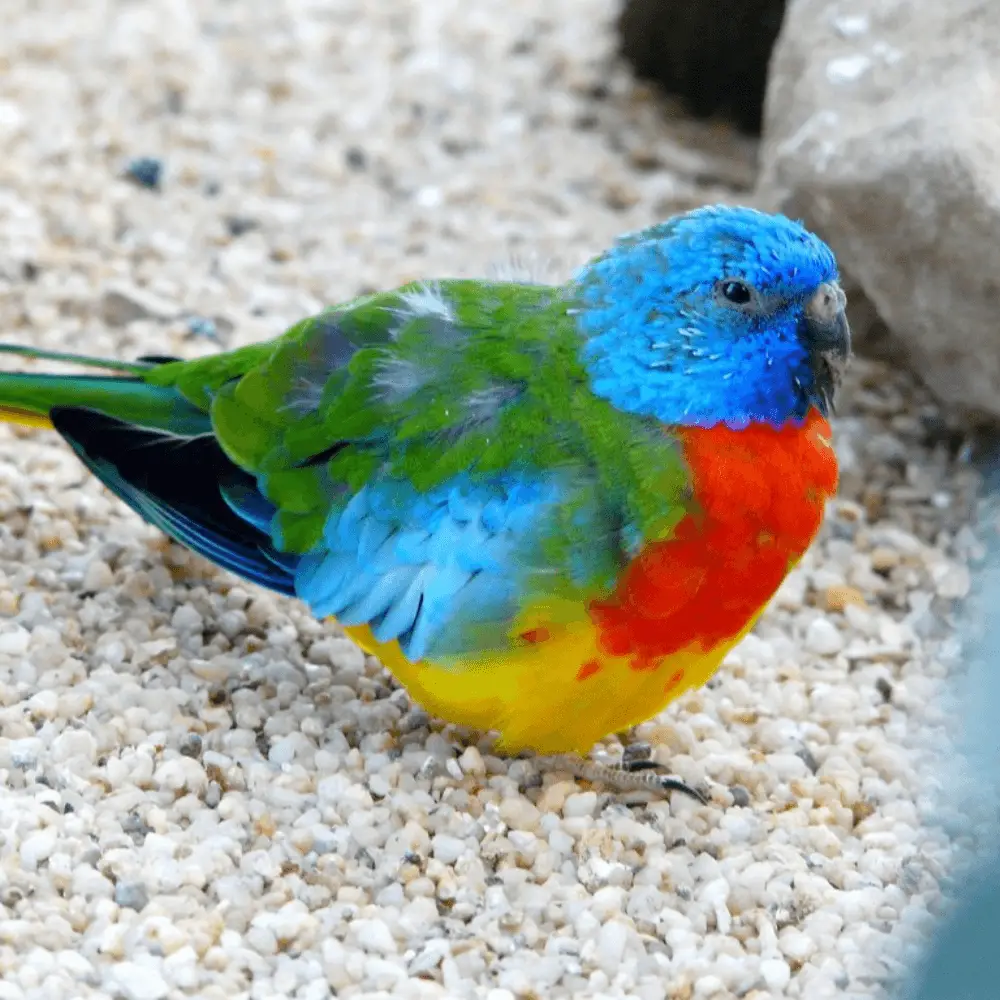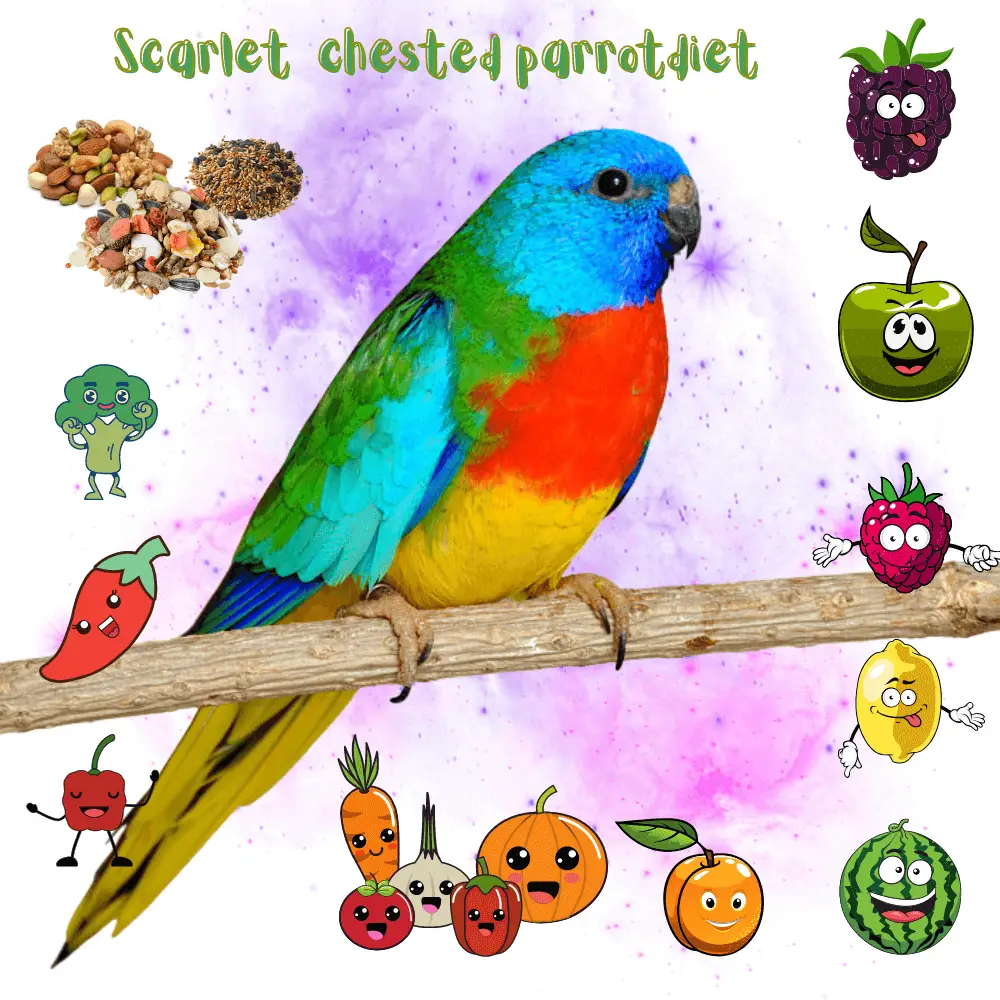Like most hookbills, Scarlet-chested parrot is a true parrot, meaning they have hooked beaks and larger heads capable of greater brain power.
They are popular for their vibrant and colorful plumage, and they are generally peaceful and quiet. As a pet, they tend to have a gentle temperament. They are small, don’t need a large footprint, and can be docile and affectionate parrots if they spend a lot of one-on-one time with you.
Common names: scarlet-chested parrot, scarlet-breasted parrot, orange-throated parrot, or splendid parrot.
Scientific name: Neophema splendida
Adult size: 8 inches long, about 2.5 ounces in
Lifespan: 10 to 15 years
Origin and history
This bird species is a kind of herbivorous parakeet native to southern and western Australia and New South Wales. In the wild, they forage on the ground and fly low, keeping close to cover.
They thrive in a variety of climates, including dry interior regions, eucalyptus woodlands, arid areas, and forest edges. They also move on land from one water source to another, often in large groups.
Scarlet chested parakeet as pets

For many years, Scarlet-chested parrot were considered by most to be “ornamental” birds, which basically means to be seen, not touched.
This is a false characterization, as most Scarlet-chested parrot is tame and affectionate pets. However, these birds are some of the most temperamental types of parakeets that do not necessarily like to be handled as much as other types of birds.
You can train a scarlet-breasted parakeet to be comfortable with handling. Except for a few special cases, it is not a bird known for performing tricks or talking.
A scarlet-chested parrot can be a great companion for the right people. With time, patience, and proper bonding techniques, they can be loving, affectionate pets that can be socially involved with their owners.
Scarlet-chested parrot prefer to chatter quietly among themselves rather than resorting to loud squeals and contact calls.
Scarlet chested parrot talking
When they make their calls, the sound is soft, melodious, and in two-syllable notes. In a flock, they produce a slight continuous chirping sound. They emit clear, higher-pitched hisses when alarmed. Like many small birds, they are receptive to songs, music, and whistles.
Scarlet-chested parrot color
Scarlet-chested parrot feature a rainbow of brilliant colors in their plumage. It is a sexually dimorphic species, so males and females are colored differently.
Adult male Scarlet-chested parrot have dark blue faces, red breasts, and bright green backs and tops of heads. They have yellow bellies and sky-blue feathers on the underside of their wings.
Although adult females also have blue faces, green wings and backs, and green breasts, their heads are less blue and browner. Their chest and wings are green, and their abdomen and thighs are bright yellow. Like the males, they also have yellow feathers on their bellies.
Caring for Scarlet-chested parrot
Relatively quiet and small as far as parrots go, these birds can be an ideal pet if you live in an apartment or condo. The cage should be approximately 1 meter long, 1 meter wide, and 1 meter deep.
The rungs should be no more than half an inch apart. They can get along with most other small, peaceful birds like finches and parakeets and can be housed in the same cage or aviary if there is enough room for all the birds.
Red-breasted parakeets prefer a warm, dry climate. They are uncomfortable in humid conditions and cannot withstand extreme temperatures.
These birds prefer to bathe in standing water or on moist foliage. Keep a small bowl of clean bath water inside the cage. They also like to sunbathe by fluffing their feathers and folding their wings.
Scarlet chested parrot diet

Scarlet-chested parrots in the wild have a diet of mostly grasses and seeds found in the fields where they live. Their diet is supplemented with other offerings available throughout the seasons, including flowers, fruits, insects, and berries.
In captivity, they seem to do fairly well on seed mixes intended for small parrots or parakeets with a supplement of canary and sunflower seeds. They also like sprouts and green leaves like spinach and kale.
Offer these fresh vegetables daily, along with pieces of fruit such as apples, bananas, and oranges. Cuttlebones are also recommended. It contains a variety of proteins and, above all, calcium.
Scarlet-chested parrot Health
Since scarlet-breasted parakeets are accustomed to staying in dry places, they can suffer from respiratory problems when exposed to extreme cold and humidity.
As a preventive measure, remove from their diet anything that promotes fungal growth, such as refined flour and sugar (most ripe fruits). Add natural antifungals to their diet, such as fresh crushed garlic, oregano, thyme, and rosemary.
Like most other parrots, they can start plucking or self-harming if they don’t have enough room in their cage or don’t have time to fly out of the cage.
Scarlet chested parakeet price

If you want to know if a Scarlet-chested parrot would be a good addition to your family, the best thing to do is contact your local poultry company or a nearby Scarlet-chested parrot breeder.
Any good breeder or adoptive organization will want to make a sustainable placement for their birds.
Describe your home and lifestyle to people who know the species and get sound advice on whether adopting one of these birds would be a good option for you and your family. These birds cost on average between 250 and 300 dollars.

